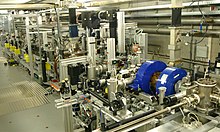DESY Zeuthen
The DESY Zeuthen is the second site of the German Electron Synchrotron in Hamburg , located in Zeuthen on the southeastern outskirts of Berlin .
History of origin
The roots go back to the Reichspostminister Wilhelm Ohnesorge , who set up a nuclear physics institute of the Reichspostministeriums in Miersdorf near Berlin during the Second World War .
After the war and the partial dismantling of important technical and scientific devices and components by the Soviet Union , the Laboratory for Science in the Soviet Occupation Zone and the later GDR was a starting point for research in the field of cosmic radiation .
After the Second World War, activities in applied nuclear physics were prohibited in Germany by the Allied Control Council Act No. 25 . This ban has been relaxed since 1950, so that scientific work on nuclear physics began again in both parts of Germany. In the GDR this was at the universities in Leipzig, Jena, Dresden, Halle and Rostock; In Berlin, the path was taken via the German Academy of Sciences in Berlin (DAW) and the Miersdorf Institute was founded in 1950 , building on the remains of this research center of the Deutsche Reichspost in Miersdorf, a later district of Zeuthen . The first work in the field of nuclear physics in the GDR was carried out here. When the Control Council Act No. 25 for the GDR was repealed in September 1955, research work and the study of nuclear physics became possible.
The Miersdorf Institute was converted into the Nuclear Physics Institute of the DAW Zeuthen in 1956 (Head: Gustav Richter ) after the USA and the USSR had reached an agreement in 1954/55 on the peaceful use of nuclear energy. The original Cosmic Radiation Department continued in this institute , headed by Karl Lanius .
The nuclear physics institute of the DAW Zeuthen was divided into two independent research centers in 1962: “Special problems of theoretical physics” (head: Richter) and high energy physics (head: Lanius). Lanius has also set up a scientific department for bubble chambers (more precisely: physics with bubble chambers) for the experimental detection of elementary particles and commissioned Claus Grote to manage it. The theory group of the research center was headed by Frank Kaschluhn .
In 1968 the previous research center for physics of high energies was converted into the Institute for High Energy Physics (IfH) of the DAW. At the IfH, its director, Karl Lanius, worked closely with Grote.In the early 1960s, both were looking for international scientific collaborations by working with bubble chambers at CERN in Geneva and at the German electron synchrotron DESY in Hamburg-Bahrenfeld , and working on a West German-British Cooperation involved: with DESY, with Aachen and with other West German groups as well as with CERN.
Research, teaching and applications
The main research objectives were to find new elementary particles that were created in the atomic interactions. The IfH Zeuthen was an equally important partner in these research communities, both in terms of the physical analysis and the quality and quantity of the processed film recordings from the bubble chamber for particle detection. The IfH partially organized this research and thus ensured domestic and international cooperation. Claus Grote published extensively on the novel properties of the elementary particles found and detected with the bubble chamber and thus ensured a high level of international scientific interest and reputation.
The IfH supported university teaching and research in the fields of nuclear physics and the theory of elementary particles. In 1962, Karl Lanius was given a lectureship and in 1964 a professorship for physics at the Humboldt University of Berlin (HUB). Claus Grote also took on special lectures on experimental methods of elementary particle physics at the HUB from 1966 to 1970. The research work of the HUB was supported by the IfH with dissertations and habilitation theses .
An application background for the research work of the Zeuthen Institute during this time was provided by corresponding international developments in applied nuclear research, in nuclear technology and in nuclear power plants, which were reflected in the GDR: from 1956 the Central Institute for Nuclear Research (ZfK) of DAW in Rossendorf near Dresden today Helmholtz Center Dresden-Rossendorf ; from 1960 to 1990 Rheinsberg nuclear power plant northwest of Berlin.
In the period that followed, the institute established itself more and more, and collaborations with other high-energy physics institutes followed, particularly closely with the United Institute for Nuclear Research VIK Dubna near Moscow, CERN and DESY in Hamburg. DESY researches the fundamental relationships between the structure and function of matter at the highest international level. The special research facilities required for this are developed, operated and used at DESY. The work is concentrated on three main areas: research with photons, particle and astroparticle physics, and accelerator physics. The large-scale plant technology used for this purpose consists of synchrotron radiation sources, X-ray lasers, particle accelerators and detectors, and observatories for observing cosmic rays; appropriate development work is carried out for this purpose. About 2,300 people are employed at DESY, plus over 100 trainees and young scientists with about 700 diploma students, doctoral students and postdocs.
After German reunification , the Institute for High Energy Physics became part of DESY in the course of the liquidation of the Academy of Sciences of the GDR (AdW) on January 1, 1992 and since then has been its second location in Zeuthen alongside Hamburg . DESY, Zeuthen therefore belongs to the Helmholtz Association and is financed with public funds: 90% from the federal government ( Federal Ministry of Education and Research ) and 10% from the state of Brandenburg .
The Zeuthen Institute has steadily become a globally visible center of elementary particle physics. In addition to experimental and theoretical elementary particle physics, research focuses on astroparticle physics and the development of electron sources for particle accelerators. DESY, Zeuthen and its research groups are set up accordingly: astroparticle physics, photoinjector test stand (PITZ), linear collider group, particle theory group (NIC / TH), electronics group, mechanics group, data center, technical infrastructure.
Rudolf Leiste headed the institute from 1988 to 1992, Paul Söding from 1992 to 1998 , and Ulrich Gensch from 1998 to 2011 . In 2011, astroparticle physicist Christian Stegmann was appointed director of the institute. He has also been one of the DESY directors since 2019 and teaches as a professor for astroparticle physics at the University of Potsdam .
Since 2011, the DESY campus in Zeuthen has become a globally visible center of astroparticle physics. DESY, Zeuthen is involved in several international research projects in astroparticle physics. As is well known, the earth is exposed to a continuous rain of high- energy particles from space, which can provide information about the fundamental processes in the cosmos, whereby the DESY researchers use neutrinos and high-energy gamma radiation in particular .
The observation of neutrinos with telescopes has been a tradition in Zeuthen since 1988. A research group led by Christian Spiering helped initiate the neutrino telescope in Lake Baikal and played a key role in its construction from 1990–98. Participation in the AMANDA experiment began in 1995. Zeuthen also worked on the IceCube research facility , the largest high-energy neutrino telescope, on the initiative of Spiering. It was completed at the end of 2010 and, with its current size, delivers an unprecedented level of sensitivity. For the next few years, the results of the Zeuthen research are expected to lead to the discovery of sources for the high-energy neutrinos.
To research the processes in the universe, gamma rays are analyzed by gamma telescopes. With DESY participation, more than one hundred sources of gamma radiation have been discovered with such systems in recent years. This success story is to be continued with a new generation of Cherenkov telescopes , with DESY, Zeuthen participating in the construction of a gamma telescope prototype and with simulation studies. With the planned more than 100 telescopes in the Cherenkov Telescope Array , the discovery potential for galactic and extragalactic gamma sources will increase significantly.
Theoretical astroparticle physics in Zeuthen is looking for an understanding of acceleration mechanisms that generate high-energy particles. These theoretical investigations complete the scientific work of the experimental physicists.
The Zeuthen research on astroparticle physics with high-energy neutrinos and gamma rays should open new windows for exploring the universe at the highest energies. The main scientific questions here include:
- the origin of cosmic rays,
- the nature of dark matter and other exotic components of cosmic matter and
- particle physics in previously unattainable areas of its parameters.
Web links
- From Institute X to DESY - a German story , accessed on March 15, 2018
- Thomas Stange: The genesis of the Institute for High Energy Physics of the German Academy of Sciences in Berlin (1940-1970). Doctoral thesis, DESY-THESIS 1998-019 , accessed on March 15, 2018. Published as a book: Thomas Stange: Institute X: The beginnings of nuclear and high-energy physics in the GDR. Vieweg + Teubner Verlag, 2001, ISBN 3519004003 . ( Review by Claus Grote )
Individual evidence
- ↑ Nuclear research in the GDR as large-scale research? The Central Institute for Nuclear Research in Rossendorf around 1960
- ↑ DESY in Brandenburg - Symposium on the 20th anniversary of the signing of the state treaty on November 11, 1991. German Electron Synchrotron , accessed on April 29, 2020 .
- ↑ Christian Stegmann - Director for Astroparticle Physics. German electron synchrotron , accessed on April 18, 2019 .
Coordinates: 52 ° 20 ′ 42.9 ″ N , 13 ° 37 ′ 59.5 ″ E

